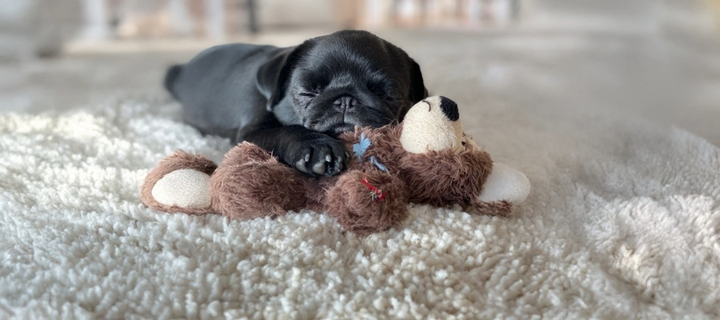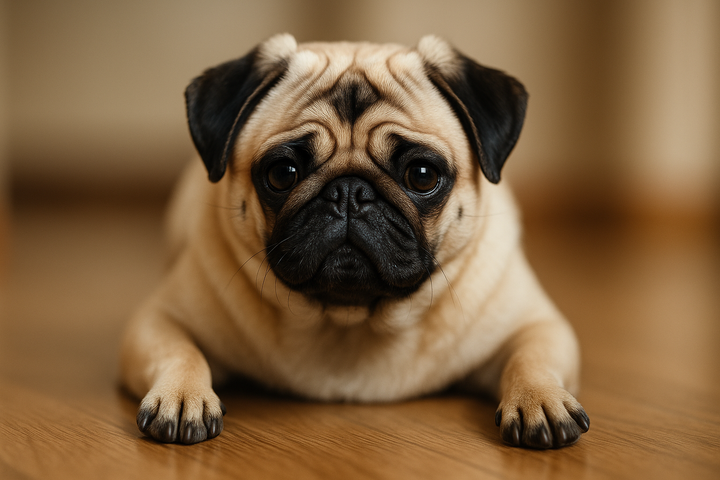Pug Training 101: Smart Yet Stubborn — How to Get the Best Out of Your Pug
Discover how hard pugs are to train, plus 20 positive-reinforcement tips for puppies, adults, and seniors. Master pug obedience with Club Pug today.

Are Pugs Easy or Hard to Train?
Pugs score in the “fair working & obedience” bracket of canine intelligence—roughly 57 out of 130 breeds—which means they usually grasp a new cue in 40–80 repetitions and obey the first command about 40 percent of the time.(articles.hepper.com)
So, while pugs are smart enough to learn most skills, they’re also famously food-motivated, people-oriented, and a bit head-strong. Consistency and high-value rewards tip the balance from “selective hearing” to eager cooperation.
10 Core Training Principles for Pugs
- Lead with Positive Reinforcement – Treats, praise, and play trump scolding every time, especially for brachycephalic breeds that can become anxious under harsh methods.(wired.com)
- Keep Sessions Short (5–10 min) – Pugs tire and overheat quickly; several mini-lessons beat one long drill.
- Train in Cool, Quiet Spaces – Reduce distractions and protect their sensitive airways.
- Use a Front-Clip Harness – Prevents throat pressure and gives you gentle steering control.
- Time It Right – Work before mealtime so treats carry maximum value.
- Pair a Clicker or Marker Word – “Yes!” + treat locks in correct behavior.
- Fade Treats Gradually – Shift to variable rewards (every 2nd, then 3rd time) so obedience sticks.
- Socialize Early & Often – New sights, sounds, and safe dog meet-ups curb reactivity later.
- End on a Win – Finish each session with an easy cue your pug knows well; celebrate.
- Track Progress – A simple journal shows which cues need extra reps and when to level up.
Age-by-Age Training Road-Map
| Life Stage | Goals | Daily Focus |
|---|---|---|
| 8 wks – 6 mos (Puppy) | Socialization, potty-training, name recall | 5-min sessions × 4; crate games, gentle leash walking |
| 6 mos – 2 yrs (Adolescent) | Impulse control, polite leash skills, trick basics | 10-min sessions × 3; “Leave-it,” “Stay,” short agility |
| Adult (2 – 7 yrs) | Reliability around distractions, advanced tricks | 15-min sessions × 2; sniff-walks, rally obedience |
| Senior (7 yrs +) | Low-impact mental workouts, stretching | 5-min sessions × 2; scent boxes, gentle “pug-a” yoga |
Practical Exercise & Training Ideas
Indoors
- Snuffle-Mat “Find It” – Engages nose and brain.
- Treat-Dispensing Puzzles – Slows eating, builds problem-solving.(pugboxes.com)
- Hide-and-Seek Recall – Family members call the pug from room to room.
Outdoors (Cool Weather Only)
- “Sniffari” Walks – Let the nose lead; reward eye contact.
- Low-Bar Agility – 4-inch jumps, weave poles made from cones.
- Structured Playdates – Practise sit-to-greet before off-leash fun.
Troubleshooting Common Pug Training Challenges
| Issue | Why It Happens | Fix |
|---|---|---|
| House-Soiling | Small bladder + stubborn streak | Crate training, potty bells, reward outside peeing instantly.(petcarerx.com) |
| Selective Hearing Outside | Competing scents and sounds | Reinforce name recall indoors first, then add distraction gradually. |
| Pulling on Leash | Excitement, short legs | Front-clip harness, stop-and-stand still whenever leash tightens. |
| Food Begging | Food obsession | Scheduled meals, ignore table scraps, use kibble for training. |
When to Call a Professional
- Repeated aggression or resource guarding
- Severe separation anxiety
- Zero progress after 4-6 weeks of consistent effort
Look for force-free, positive-reinforcement trainers certified by CCPDT or IAABC. Many offer virtual sessions if you live far from urban centers.
Key Takeaways
- Yes, pugs can learn quickly, but motivation is everything.
- Short, upbeat sessions plus tasty rewards equal success.
- Consistency and patience tame the famous pug stubbornness.


Comments ()